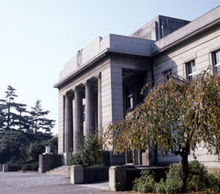Sūmitsu-in

The Sūmitsu-in ( Japanese 枢密院 ) was an advisory body to the Japanese Emperor ( Tennō ) from 1888 to 1947 .
As a model that served Privy Council of the British monarch , so there is also a Privy Council called on German Privy Councilor , Privy Council or State Council .
The Sūmitsu-in was established by imperial decree on April 28, 1888 under the chairmanship of Itō Hirobumi . The first task was to draft a Japanese constitution. So it was in competition with the Senate, the Genrōin , whose draft constitution a decade earlier u. a. was rejected by Itō Hirobumi as too liberal.
The new, so-called Meiji Constitution briefly mentions the Sūmitsu-in in Chapter 5, Article 46: "The Privy Council shall, in accordance with the provisions on the organization of the Privy Council, advise on important state affairs when it is consulted by the Emperor."
The Privy Council advised the Emperor on important matters including:
- Creation and revision of the Imperial Household Law (enacted 1889) and the Constitution (enacted 1890)
- Interpretation of the Constitution, legislative proposals and motions for ordinances
- Imposition of martial law and declarations of war
- International treaties and other international agreements
- Succession to the throne and reign according to the Imperial Budget Act
- Other matters to be submitted to the Emperor (as directed by the Cabinet )
The Privy Council thus had both judicial and some executive functions. However, he had no legislative powers because he could not introduce laws.
The Privy Council consisted of a chairman ( 枢密院 議長 , sūmitsu-in gichō ), a deputy chairman ( 枢密院 副 議長 , sūmitsu-in fuku-gichō ) without a vote, 12 (later 24) council members ( 枢密 顧問 官 , sūmitsu komonkan ), one Chief Secretary and three additional secretaries. All councilors, including the chairman and vice-chairman, were appointed for life by the Emperor, on the advice of the Prime Minister and the Cabinet.
In addition to the 24 voting members, the Prime Minister and the other ministers were ex-officio members of the Privy Council. The princes of the imperial house (both the shinnōke and the ōke ) were also entitled to attend meetings when they came of age. The chairman had special rights because he called the meetings and set the agenda. The Privy Council met in secret in the Imperial Palace , at important meetings in the presence of the Emperor. It was entitled to deliberate on any questions on which the emperor wished to obtain an opinion.
Assessments of the Sūmitsu-in's political influence range from claims that it was the most powerful body of the Meiji government (arguably legally correct) to claims that it was completely irrelevant in shaping national politics (in actual practice probably so). In the first few years after it was founded, many ministers and other influential politicians also had a seat on the Privy Council. Later, however, it became an “old boys” club that was often in conflict with the government. After several attempts by the Sūmitsu-in to reject government decisions and to assert himself on foreign policy issues, it became clear that the balance of power was in favor of the government. During the attack on Pearl Harbor and the subsequent declaration of war, the Privy Council was not even consulted.
With the enactment of the post-war constitution on May 3, 1947, the Sūmitsu-in was dissolved.
Chairperson
swell
- WG Beasley: The Rise of Modern Japan . Palgrave Macmillan, 2000, ISBN 0-312-23373-6 .
- Kenneth W. Colgrove: The Japanese Privy Council . 1931.
- Andrew Gordon: A Modern History of Japan: From Tokugawa Times to the Present . Oxford University Press, 2003, ISBN 0-19-511061-7 .
- Marius B. Jansen: The Making of Modern Japan . Belknap Press, 2000, ISBN 0-674-00991-6 .

